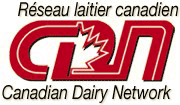 This Code of Ethics provides guidelines for the fair and ethical publication of information associated with dairy animals, embryos and semen in Canada. Detailed guidelines and methods of expression are available from the indicated accountable organizations. Abiding by the code is strongly encouraged and shall be enforced by Canadian Dairy Network to its member organizations and/or the appropriate breed association to its members. Published information must contain accurate genetic, phenotypic and herd book information.
This Code of Ethics provides guidelines for the fair and ethical publication of information associated with dairy animals, embryos and semen in Canada. Detailed guidelines and methods of expression are available from the indicated accountable organizations. Abiding by the code is strongly encouraged and shall be enforced by Canadian Dairy Network to its member organizations and/or the appropriate breed association to its members. Published information must contain accurate genetic, phenotypic and herd book information.
Genetic Information
The publication of genetic information includes promotional ads for individual animals or groups, sale catalogue pages, sire directories and/or proof sheets typically produced by A.I. organizations, and animal lists and/or genetic profile details provided via Internet web sites.
- For all forms of publication, genetic information must conform to the publishability guidelines and methods of expression provided by the Canadian Dairy Network (CDN).
- Foreign genetic indexes expressed in Canadian equivalents must meet criteria approved by CDN and be provided directly by CDN.
- When any genetic evaluation information is presented for which the Canadian dairy producer is a key intended audience, the following order of information priority must be respected:
- In all cases when an official, domestic genetic evaluation is published by CDN, it must be used for publication in all forms. This includes progeny proven sires with daughters in Canada, cows with performance data in Canada as well as all heifers and all young bulls regardless of country of origin. Foreign genetic evaluations may be included as additional information.
- For progeny proven sires and cows with performance data in the United States, the official genetic evaluation as published in that country may be used for publication in Canada and/or any MACE evaluation published by CDN may be used.
- For progeny proven sires and cows with performance data in a foreign country other than the United States, any MACE evaluation published by CDN must be used for publication in Canada and if no MACE evaluation is available, only then shall the official genetic evaluation as published in that country be used.
- In any case where genetic evaluation information is provided, it must be properly labelled (as outlined in the table below) and be accompanied by at least the following details:
- Country and/or organization (i.e.: USA, USDA, HO USA, etc.) of source if not Canadian
- Date of evaluation as displayed by either CDN or the breed association (i.e.: Jan*10 or 10*Jan)
- Reliability for LPI or the overall genetic index from a foreign country (i.e.: TPI, NM, etc.), as officially published
- Evaluations that include genomics must be indicated as such, either explicitly or by the use of the “G” prefix in association with the following labels used for Canadian-based evaluations.

- For genomic evaluations, Direct Genomic Values (DGV) shall only be provided in conjunction with the associated official Canadian-based genetic evaluation (i.e.: GLPI and DGV for LPI or GEBV/GPA and DGV for a specific trait).
- Promotional ads do not require inclusion of genetic evaluation details as prioritised in point (3) above, but when such information is included, it must conform to the requirements outlined in (4). The sole exception is that Reliability for LPI is not required to be included if LPI is the only genetic evaluation provided without any other trait information.
Phenotypic Information1.
- Phenotypic information must conform to guidelines and methods of expression provided by CDN, breed associations and the Canadian Dairy Herd Improvement partners.
- Classification information that is not Canadian must be indicated.
- Lactation records must represent most recent official information available and include age at calving, days in milk, unit of expression if not kilograms.
- For sires, summary or average daughter performance data must be accompanied by the genetic evaluation for the general trait associated with the phenotypic information (i.e.: usually production yields or Conformation).
- Use of photos must have no enhancement or manipulation for the intent to misrepresent the conformation of the animal.
Herd Book Information
- Herd book information must follow the guidelines and methods of expression provided by the breed associations.
- For animals not purebred, the level of purity must be indicated.
- Animals with known recessive genes must be indicated.
Signatory Organizations/Policy
This Canadian Dairy Industry Publishing Code of Ethics will be widely circulated and publicly available on web sites of industry organizations, including CDN and the breed associations. Breed and/or breeder magazines for which the primary audience includes Canadian dairy producers must abide by the above Code of Ethics when accepting promotional ads for publishing. Signatories of this Code of Ethics will be broadly advertised in a manner that recognizes their interest in the fair and appropriate delivery of accurate information to Canadian dairy producers. Any case of breach in this code of ethics shall be brought to the attention of the appropriate organization, which is the breed association for herd book information and CDN for all other information.
Source: Canadian Dairy Network









